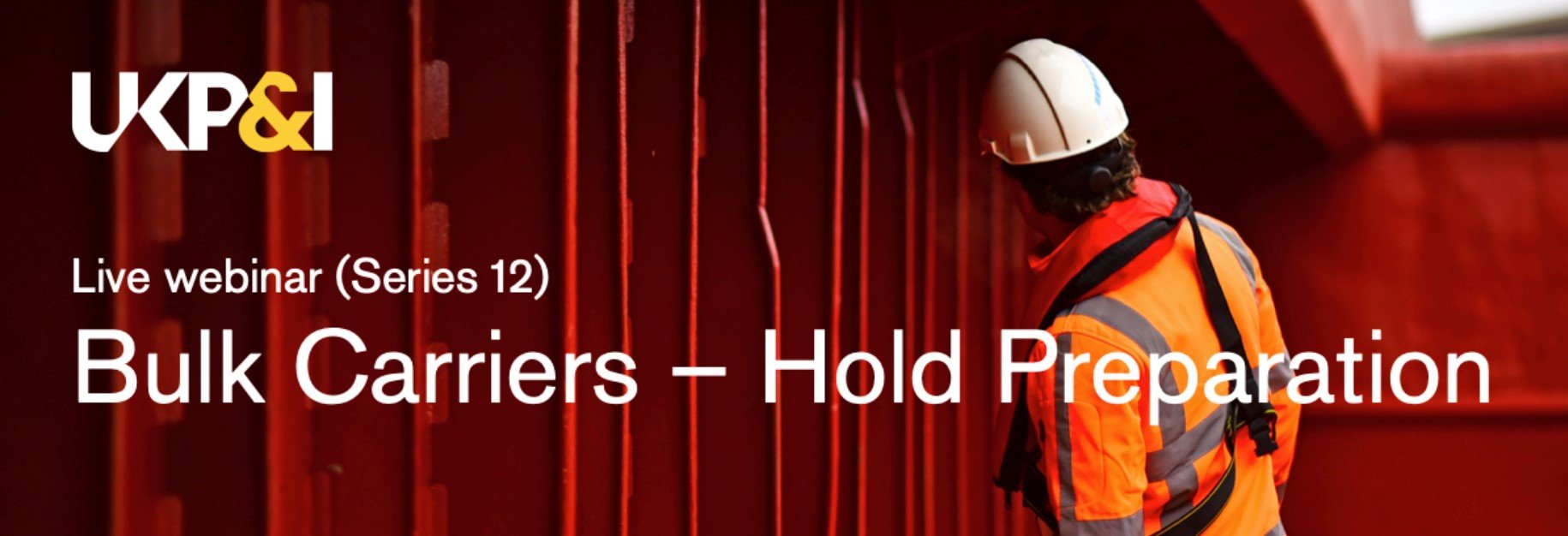
Introduction
1. The preparation of cargo holds for the next intended carriage is a critical operation which requires careful planning and execution.
2. A lack of proper preparation may lead to claims for contamination, water ingress or shortage as well as contractual disputes. It is essential that those involved understand exactly what is required of them under the charterparty in terms of cleaning and preparation.
3. This article considers a number of legal issues which may arise, including terms commonly used in charterparties to describe the cleanliness of cargo holds, the consequences of failing to comply with such terms, potentially resulting in off-hire claims and damages, and the role of the independent surveyor.
4. We will look at these issues in the context of three cases:
a) London Arbitration 14/18
b) THE “BUNGA SAGA LIMA” [2005] 2 Lloyd's Rep. 1
c) London Arbitration 7/10
Charterparty Terms
5. The relevant terms between Owners and Charterers are typically found in charterparties and fixture recaps, negotiated and disseminated in advance of the charter.
6. Standard contracts such as the BIMCO NYPE 46 and NYPE 93 forms are commonly used but are usually heavily amended with additional wording and clauses. It is therefore important to read the charterparty and recap carefully to fully appreciate what has been agreed.
7. Various expressions are used within these charterparty and recap terms and it is useful to be familiar with them. These include:
a) Hospital Clean” is the most stringent and requires all hold surfaces to have 100% intact paint coatings on all surfaces (including the tank top, all ladder rungs and undersides of hatches).
b) “Grain Clean” requires the holds to be free from insects, odour, residue of previous cargo, lashing material, loose rust scale and paint flakes, etc. Prior to loading, the holds must be swept, washed down with fresh water, dried and well ventilated. This is the most common requirement.
c) Normal Clean” requires the holds to be swept to remove all residues of the previous cargo, washed down and dried ready to receive a similar or compatible cargo.
d) Shovel Clean” does not require washing but only the removal of the previous cargo by rough hand or mechanical sweeping.
e) “Load on Top” is when new cargo is loaded on top of existing cargo residues. This is most appropriate in certain long-term contracts where a particular vessel is routinely transporting the same cargo.
8. The most common requirement is for a hold to be “Grain Clean”, but as we will see the clause may be amplified – for example: “holds clean swept, washed down by fresh water, dried, free of salt, rust scale and residue of previous cargo”.
The independent surveyor
9. The charterparty might also require that the cleanliness of the hold be “…determined by an independent surveyor…”. What does this mean?
10. In the English case of Protank Shipping Inc. v. Total Transport Corporation (the “Protank Orinoco”) [1997] 2 Lloyd's Rep. 42, the Commercial Court considered the meaning of this term. The case related to a charterparty clause permitting the deduction from freight where cargo remained on board after the completion of the discharging operation. The amount involved was to be "...determined by an independent surveyor whose estimate shall be final and binding...”.
11. Thomas J held at p.42 “…if the meaning of “independent” was satisfied by showing that the surveyor in question was a firm or organization that operated independently of the owner or charterer or receiver, then there was always the likelihood that at any port of discharge there would be more than one surveyor who was “independent”…”. However, by the inclusion of the words “…whose estimate shall be final and binding…” the charter party clause must have envisaged the appointment of a surveyor jointly on behalf of the parties to make the determination that was final and binding.
12. What if the words “…final and binding…” were not included? Thomas J went on to observe at p. 46 “…Quite apart from that, I consider that it is highly unlikely that the parties would have intended to entrust such an important determination which would final decisions on significant sums of money unless the person was jointly appointed.”.
13. Following this decision, it is considered that an independent surveyor must be jointly appointed by the parties. Charterparties: Law, Practice and Emerging Legal Issues (Baris Soyer and Andrew Tettenborn), 2018 Edition p.168 observes “It was held in [The Protank Orinoco] that in the absence of any other clarifying words an “independent inspector” was one that had been jointly appointed by the shipowners and charterers…”.
London Arbitration 14/18
14. Such a conclusion was also reached by the tribunal in London Arbitration 14/18, which considered the requirement to present a cargo hold which was “free of salt”.
15. Clause 11 of the fixture recap provided that the vessel’s holds be “…clean swept/washed down by fresh water and dried up so as to recve chtrs int cgos in all respects, free of salt, loose rust scale and previous cgo residue to the independent surveyor satisfaction”. In that case, silver nitrate testing was carried out by a surveyor who had been instructed by charterers for their own account.
16. At the first loading port, in Vietnam, the charterer conducted an on-hire condition survey. Despite the Masters’ protests, a surveyor was instructed by the charterers to conduct silver nitrate testing in the ship’s holds. Alleged salt traces were detected, and the ship was placed off hire.
17. Having first reserved its position that the holds were contractually compliant, the owner arranged freshwater washing of the holds (under protest) to minimise delay. The cargo (steel) was then loaded.
18. At the second load port, in Korea, the charterer alleged that water dropping from the hatch cover had further contaminated some steel pipes in the holds with salt. A debate developed as to the origin of salt on the pipes. To minimise delay, the crew mopped the tank tops in the holds to remove cargo and hold “sweat”. Again, the charterers placed the ship off hire for the duration of the stoppage. With mopping complete, the holds were approved for loading.
19. The owners claimed a balance of hire in respect of the periods in which the charterers had withheld hire at the first and second loading ports.
20. The charterers alleged that the silver nitrate test was customary when loading steel products. Based on the results of such tests, they were entitled to place the vessel off hire for the periods which they did. In their view, the presence of any salt meant that the hold was not “free of salt”.
21. The owners argued that the charterers’ construction of the term “free of salt” was flawed and that the silver nitrate test was not appropriate to establish compliance of the vessel’s holds with the relevant clause. They owners submitted that it cannot be expected that a seagoing vessel be entirely free of any traces of any chloride.
22. The tribunal found in the owners’ favour. They held that charterers had failed to establish that the silver nitrate test was customary. Considering its extreme sensitivity, it would be surprising if that was indeed the case.
23. As to the construction of the words “free of salt”, the tribunal was not convinced that the literal interpretation which the charterers ascribed to it should be preferred. It considered it unrealistic to expect a vessel in a maritime environment to be free of any salt whatsoever.
24. The tribunal considered that a more realistic and commercially sensible interpretation of the words would be ‘free of any significant traces of salt’.
25. The tribunal found that “It was common ground that the silver nitrate testing had been undertaken for the account of the charterers and not jointly on behalf of both parties. Therefore, X could not be regarded as “independent” for the purposes of Clause 11”.
26. The provision in the clause which stated that the vessel would be off hire in the event that the holds were not to the satisfaction of the independent surveyor was to be construed against the party seeking to rely on it, that is the charterers.
27. As the findings on which the charterers sought to rely were the product of unilateral testing by a surveyor acting only on the charterer’s behalf, the tribunal found that the charterers had not succeeded in bringing themselves within the relevant clause.
“BUNGA SAGA LIMA” [2005] 2 Lloyd's Rep. 1
When must the hold be clean?
28. Another question which arises is at what point the owners of a vessel must ensure that the holds are clean. Typical contractual terms include: “Upon arrival at the first loading port”; “On arrival at load port”; “On delivery” or “On first loading”.
29. In the “Bunga Saga Lima” [2005] 2 Lloyd's Rep. 1, the vessel Bunga Saga Lima was chartered on an NYPE 93 form as amended for a short time charter period comprising two or three laden legs.
30. The charterparty required as follows:
- Line 21 - “Vessel on her delivery to be ready to receive cargo with clean swept holds and tight, staunch, strong and in every way fitted for the cargo as per clause 29, having water ballast…”.
- Clause 46 (amended) – “…it is understood that on dely or upon arrvl 1st loading port, vsel to be clean grain standard up to independent surveyor’s satisfaction”
- Clause 13 of fixture note – “Owners warrant that vsl’s holds on delivery or arrival first load port to be cleaned, swept washed down with freshwater, dried up free from rust leaks, scale, free from salt and free from residue of previous cargo and in every respects ready to load up to the satisfaction of the local surveyor.Should Vessel fail to pass hold inspection Owners to arrange cleaning at their time and expense and the Vessel to be off-hire from the time of failure until survey passed in all holds and any extra or directly related expenses incurred to be for the Owners acct”
31. At the time of delivery under the charter at the first loadport at Sepetiba, Brazil, the vessel’s holds were dirty with coal residues from a pre-delivery cargo. However, the charterers loaded a cargo of iron ore without requiring the remaining coal residues to be removed. The iron ore cargo was carried to Swinoujscie, Poland, where it was discharged.
32. The charterers then decided to load a cargo of rapeseed in bulk at Rostock, Germany, so the coal residues had to be removed. This resulted in a delay while the holds were cleaned to a ‘grain clean’ standard.
33. The charterers alleged that the owners were in breach of the cleanliness warranties under the charter, and that the charterers were entitled to place the vessel off-hire at Rostock until the holds were passed ‘grain clean’.
34. The tribunal found that at the time of delivery at the first loadport, both the charterers and the owners knew that the holds did not comply with the ‘grain clean’ requirement. They therefore rejected the charterers’ claims.
35. Although the vessel did not need to be cleaned to load iron ore, by not insisting on clean holds on delivery, the charterers had lost their right to claim for the loss of time and expense incurred to clean the holds at the second load port.
36. Under the NYPE and Fixture Note, the only entitlement to place the vessel off-hire in the event of unclean holds was upon delivery or arrival at the first load port, and not thereafter.
London Arbitration 7/10
37. In London Arbitration 7/10, on similar facts to the “Bunga Saga Lima”, a vessel was chartered on an NYPE form with the following terms:
- Line 22 of NYPE - “…Vessel on her delivery to be ready to receive cargo with clean-swept holds…”.
- Clause 54 – “Vessel’s holds conditions on arrival at first loading port to be fresh water washed down, clean dry, free from loose rust flakes/scales and residues of previous cargo and in every way ready and suitable to load Charterers’ intended cargo to the satisfaction of the independent surveyor. If vessel is rejected by the independent surveyor at load port, vessel to be off-hire until ready to pass inspection…”
38. The vessel was delivered to charterers in Haldia, India after discharging her last (coal) cargo under her previous charter. She then sailed in ballast to Thailand to load her first cargo (steel) under the charter. Her holds were cleaned by the crew during the ballast voyage.
39. On arrival at the loadport, the charterers’ on-hire surveyor found the holds to be in a sound condition but noted dark staining on the bulkheads and sides, caused by the pre-charter coal cargo. The vessel loaded the cargo of steel. She sailed from Thailand to the United States. During the voyage, she was fixed to load grain at Vancouver, Washington state.
40. Subsequently, the vessel arrived and discharged the steel in Kalama, Washington state. An NCB surveyor inspected the holds and required removal of the coal staining. The Charterers were concerned that the holds would fail inspection at Vancouver. Therefore, the Master had the holds cleaned with chemicals to remove the staining.
41. The vessel arrived at Vancouver seven hours after completion of discharge at Kalama. USDA and NCB inspectors rejected her holds, apparently due to the coal staining. After a further five days of cleaning by the crew and a shore team, the vessel’s holds were passed at a re-inspection.
42. Charterers alleged that owners were in breach of the charter because the vessel’s holds were not, on delivery in Haldia, in a fit state to receive grain cargo at Vancouver due to the presence of coal residues.
43. The tribunal rejected the charterers' claim. The charterparty was specific about how clean the holds had to be and when. On arrival at the first loadport, the holds had to be sufficiently clean to load the intended cargo (steel). The crew were given the chance to clean the holds properly, not before delivery but during the ballast voyage to the first loadport – after delivery.
44. The owners had complied with their charterparty obligations because the crew cleaned the holds properly during the ballast voyages to the loadport. The charterers accepted the ship unconditionally, and the owners were not liable for the vessel's arrival at the second loadport in a non-grain clean condition. This was consistent with the decision in The Bunga Saga Lima.
Preservation of Evidence
45. In the event of a dispute or even potential dispute, it is important that those involved secure contemporaneous evidence an early stage to protect their position. This might include:
-
Initial correspondence
-
Notes of telephone calls
-
Fixture recap
-
Charterparty
-
Instructions to crew and/or contractors
-
Attendance of surveyors
-
Notes of protest
-
Cleaning records
-
Note books
-
Photographs
Conclusion
46. In conclusion, it is important that the following steps are taken:
- Consider charterparty and fixture recap terms carefully;
- Comply with the terms of the charterparty;
- Seek prompt advice if unsure; and
- Preserve all evidence.
Andrew Gray
Director & Mariner
andrew@cjclaw.com
Campbell Johnston Clark




